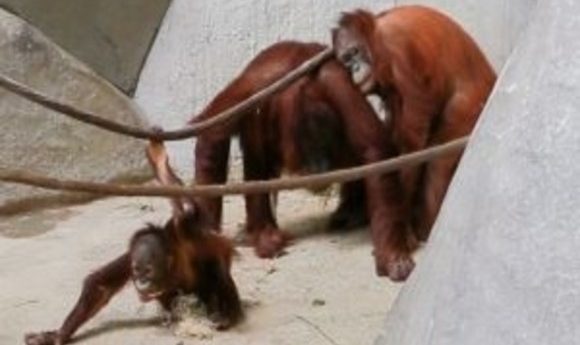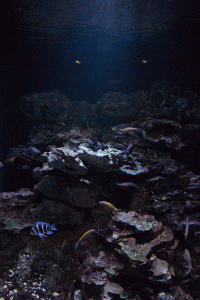A global debate: can we synthesize nature to stop the loss of biodiversity?

In recent years, synthetic biologists have proposed ways to help conservationists mitigate the loss of biodiversity through innovative biotech. However, the conservation community worries about the implications of synthesizing nature. Can the two disciplines cooperate to halt the loss of biodiversity?

According to the IUCN Red List of Threatened Species, Sumatran orangutans are “critically endangered.” Primary reasons include deforestation for palm oil production and deliberate (and illegal) killing of orangutans when they raid palm plantations for sustenance.
Photo credit: Rashmi Shivni, taken at the Brookfield Zoo in Illinois.

Overexploitation and pollution have increased the number of endangered marine species around the world.
Photo credit: Rashmi Shivni, taken at the Brookfield Zoo in Illinois.
Swinging through Sumatran rainforest canopies, an orangutan searches for sweet jackfruit. She heads to her favorite patch of the forest and finds a plume of blue smoke billowing up the hill. She moves around the clearance to see what’s ahead—a new grove of planted palms forms neat lines. Her beloved jackfruit trees, replaced; her home, reduced.
The Sumatran orangutan is a poster child for conservation. At the December 2016 UN Convention on Biological Diversity (CBD) in Cancun, Mexico, experts met to discuss similar biodiversity losses and how to protect endangered wildlife. Forums such as the CBD foster large-scale public dialog and urge immediate action. But because biodiversity loss is pervasive, conservationists seek more expertise and concerted efforts to mitigate wildlife decline. Recently, several disciplines have joined the conversation; however, the participation of some technology-driven disciplines, such as synthetic biology, seems counterintuitive to conservation.
While conservation scientists focus on preserving and protecting biodiversity, synthetic biologists create and design new biological parts and systems. Some biotechnologies hold promise for in-the-field conservation; however, untested biotech raises some concerns (1). With this in mind, conservationists and synthetic biologists initiated a critical debate: Can synthetic biology provide additional means for biodiversity conservation?
“[It’s important] for us to understand the circumstances where synthetic biology could be beneficial and where it can’t,” said Elizabeth Bennett, Vice President for Species Conservation at the Wildlife Conservation Society (WCS). “We want to take the emotional ‘knee-jerk’ reactions out of the discussions and put some real solid science and debate into this.”
Biotech Tools for Your Conservation Concerns
Synthetic biology is an emerging science, so most available tools remain in controlled laboratory environments. For many of the solutions proposed at the CBD and other conservation meetings, synthetic biologists envisage scenarios where biotech could be beneficial for conservation.
Recent technological advances made synthetic biology techniques easier, cheaper, and more precise. The emergence of CRISPR/Cas editing, gene drives, and innovations in genetic modification (GM) have potential applications in several conservation areas. For example, Sylvatic plague recently decimated the North American black-footed ferret population, and CRISPR/Cas9 offers a practical solution for cutting the part of the ferret’s genome that makes it susceptible to the disease (2).
According to the International Union for Conservation of Nature (IUCN), island biodiversity is in major decline due to invasive alien species. Humboldt penguins, endemic to islands near Chile and Peru, often compete with invasive mice for burrow space and food. Synthetic biologists suggest eradicating invasive species using gene drives because currently available methods, such as poisoning, pose risks to other island wildlife. To create a gene drive, scientists place a sex-determining SRY gene on an autosome so that all offspring are born male, quickly leading to the demise of the population (2).
In the GM realm, some synthetic biologists are moving from transgenics to other gene transfer techniques such as “cisgenics” and “intragenics.” The former involves transferring genes from related species, and the latter is the reorganization of a gene region within a species (3). In practice, some experts believe cisgenics might work in transferring genes from acidity- or heat-resistant coral to the larger coral reef as climate change and pollution alter the chemistry of Earth’s oceans.
“In the last 3 or 4 years, I’ve noticed that overall interest in synthetic biology has increased,” said Gernot Segelbacher, a research scientist at the University of Freiburg and chairman of the Conservation Genetics Specialist Group of the IUCN. “Conservation biology conferences host more talks on so many uses of genetic methods for the environment, but we need to consider taking more action as well.”
Applications in the Field
Current (or near-term) synthetic biology applications related to conservation are new and often prioritized by the private sector. Solazyme, a company developing synthetic microalgae that breaks down biomass, hopes to provide biofuels as a clean, renewable energy source (1).
Aside from business objectives, one organization is getting young biologists involved in conservation: the International Genetically Engineered Machine (iGEM) Foundation. iGEM is known for its international team competition, which consists of students building living cells from DNA kits. Some teams take the environmental route, hoping to exact positive change on biodiversity loss. Last year, a team hailing from both the Federal and State University of Amazonas in Brazil tackled mercury contamination in the Amazon rainforest. The students built a bioremediation system that treats mercury-contaminated water and used the system in the field; they also promoted the project and got the community and government to participate.
“iGEM is a great opportunity for students around the world using synthetic biology techniques to apply to local problems in their communities,” Bennett explained. “These are practical, small-scale solutions successful in getting a lot of outreach.”
One student from the Brazil team joined other iGEM delegates for the organization’s first time participating at the CBD. This student contributed to the conversation with other industry and research leaders who heard a range of opinions (from enthusiastic to apprehensive) on the use of synthetic biology for conservation.
The Double-edged SynBio Sword
For every great idea about the use of synthetic biology for conservation, there’s always a matching concern. Both conservationists and synthetic biologists agree that there’s potential for unforeseen effects when synthetic organisms interact with natural systems, so they advocate for “precautionary approaches” when tackling a problem.
Concerns are often raised regarding the use of gene drives. This genetic engineering technique rapidly spreads certain characteristics through inheritance into the larger population. In the mouse example, scientists want invasive species to breed themselves to local extinction by preventing female births. But what would happen if the SRY mice evolved in unexpected ways in the wild? Would this have any negative consequences on the ecosystem?
“Scientists use the image of Pandora’s Box because we can’t predict the negative implications of gene drives,” Segelbacher explained. “People are afraid if we open the box, it will alter the natural system in some terrible way.”
Several environmental activists called for a moratorium on gene drives at the last CBD, arguing that they break the rules set by the CBD’s Cartagena Protocol on Biosafety, which governs the migration of living modified organisms throughout ecosystems. However, attending government representatives rejected the proposition because freezing lab research and field trials would be unproductive for conservation.
“We’re currently [losing] the battle to halt the global decline in biodiversity,” said Philip Seddon, Wildlife Management Director at the University of Otago. “It is imperative to consider any new, useful tools—even if we choose not to use a new approach due to risk or uncertainty.”
Beyond the science, synthetic biology has raised ethical and economic red flags. For instance, “de-extinction” garnered a lot of press and penetrated pop-culture because it redirects conservation advocacy towards hope and redemption versus loss and despair. Some scientists see de-extinction as an opportunity to “reintroduce extinct alleles” to biodiversity, while others argue that this enterprise takes away time and resources from other at-risk species (4). In a recent review Seddon co-authored, his team noted that government or external funding to resurrect a few species would eclipse funding allocation for most extant species preservation efforts (5). It’s as if governments allocate 75 percent of conservation funds for wooly mammoths, while endangered rhinos and tigers share what’s left.
Synthetic biotechnologies also have socioeconomic and legal ramifications. For example, Indonesia’s primary export—palm oil—has deleterious impacts on Sumatran tropical rainforests (4), but if someone develops a synthetic substitute for palm oil that is adopted by industry and consumers, the nation’s economy could crumble.
Another issue lies in intellectual property and biopiracy. Several developing nations and indigenous populations are exploited by companies that patent “traditional knowledge”—information shared from generation to generation within small communities that shapes the peoples’ livelihoods. The CBD’s Nagoya Protocol on Access to Benefit Sharing aims to protect traditional knowledge related to genetic resources, such as native species found nowhere else on Earth, so that no one group deprives another of their rights and resources.
“Of the discussions at the CBD, it was even more important among the different parties on who will own or even profit from this information. Conservation is all about this sharing economy, so synthetic biologists should be aware of this,” Segelbacher said.
Goals for the Immediate Future
The CBD set goals called the Aichi Targets for nations to reach by 2020. There are 20 targets, some outlining the use of genetic materials, marine life management, and extinction prevention (6). The WCS, IUCN and even some iGEM participants focus on a few targets within their expertise to help communities reach them.
With innovative biotech, conservationists see more opportunities to reach these goals. Bennett said she hopes the dialogue continues because engagement is key for biodiversity’s success: “Protecting biodiversity is a responsibility of humankind; for the more abundant we become, the less abundant it becomes. We need to work on the policy side, on the legislation side, as well as the field research side. Conservation is a broad field, and with synthetic biology, there’s even more to consider. We need to keep at this if we’re going to have a huge level of impact on biodiversity loss.”